Ancient Views¶
Our modern enlightenment worldview is failing; failing not only to advance civilization but also failing to sustain civilization. We all feel this on some level, as if there's forces at work actively seeking to harm us. We can blame globalism or populism or the latest machination of political elites, but these are mere symptoms, the rotten fruits of a deeper nihilism.
As a result of our failing worldview, there is an inevitable resurgence of ancient worldviews. To be clear, this is not a voluntary return to ancient religions. Ancient worldviews are returning to us whether we like it or not. These are ancient patterns of reality that are manifesting all around us.
To put it bluntly: the old gods are returning.
What is a worldview?¶
A worldview is a set of beliefs and presuppositions needed to think, plan, and act in the world. It is how we "make sense" of the world. This includes the patterns of reality that we participate in.
All worldviews attempt to "make sense" of all other worldviews, subordinating those competing worldviews under a unifying principle. These are attempts at integrating all observed behavior and phenomena into a coherent model that "makes sense" of reality (including the existence of different worldviews).
pantheons and archetypes
Each worldview attempts to subordinate other worldviews through syncretism, that is, combining the competing religious principles under a higher principle. For example:
-
The Romans added the gods of conquered people to their pantheon, subordinating the foreign gods (competing worldviews) under Rome: worshipping those gods in temples and giving them Latin names, e.g., Athena became Minerva, Zeus became Jupiter, etc.
-
Our modern worldview subordinates competing worldviews by falsification and secularism, e.g., we claim Zeus and Athena are not real, mere archetypes, but that everyone is still free to practice whatever religion they want. Note the presupposition of knowable objective truth in this view.
Worldviews are not optional. There is no "neutral" nor "unbiased" worldview. Everything we experience and understand is based on our current worldview. This includes moral judgments, purpose, meaning, and knowledge about ourselves and the universe.
Worldviews are not thoughts nor beliefs. Worldviews are the presuppositions needed to even have thoughts. We adopt new worldviews only as a psychological reaction to persistent anomalies in our existing worldview. A worldview is in a sense empirically validated by its coherence and lack of anomaly (that is, when everything "makes sense").
If we experience anomalies (things that don't make sense) we will seek to integrate the anomalous phenomena into our worldview -- failure to do so results in a kind of existential crisis (and hysteria) until a new worldview is adopted which can better make sense of the new phenomena.
Worldviews are not all equal. Some are clearly more survivable and amenable to human flourishing than others.
An interesting trait of the modern enlightenment worldview is that it assumes ancient worldviews were superstitious and incomplete, products of "less evolved" and "pre-scientific" thinking. In the enlightenment worldview we imagine there's a list of different religious systems that we can pick and choose from, defaulting to "none" (as atheists are want to do). We then imagine that people of other religions are those who chose differently, usually defaulting to the religion they were born into. While this sounds nice, it has led us into cultural decay and nihilism, into a meaning crisis, unable to determine if truth exists.
Failure of the modern worldview¶
Western civilization was born from a Christian worldview that provided an ethic and an understanding of truth. Unfortunately, we succumbed to pride, starting in the age of scholasticism and again during the enlightenment, which produced our modern view, denying God, and producing nihilism. We obviously wanted to keep the fruits of Christendom (the morality, the epistemology, even the subordinating principle to make sense of other worldviews), but we wanted it all without God. We thought we had it. Our secular worldview has been trying to subordinate ancient worldviews, pushing them beneath our own intellect and passions. But it is failing, and nihilism has become inevitable.
When we claim ancient worldviews are "superstitious nonsense", we are presupposing knowable objective truth, that we know what is and what is not truth (and thus what is nonsense). And then as we fall into nihilism we increasingly lose that subordinating principle, and we can't really discern truth from nonsense (as truth becomes relative). Ironically, this nihilistic worldview has become the default worldview that our children are born into. Our culture went from no one believing nonsense to now everybody believing nonsense and trying to keep an open mind about it.
This is why we've seen so many shallow religions in our modern culture. We have been subordinating the ancient religious traditions of our ancestors into this nihilistic secularism. This is why, for example, so many people in modern churches don't seem to actually believe what they're preaching (because they don't believe it -- if they did they would behave very differently).
So what happens when this subordinating principle fails completely, when we can't subordinate the ancient gods beneath our intellect and passions? What happens when those competing worldviews (the ancient gods) are no longer subordinated at all?
We are living through exactly such a failure. As modernism gives way to postmodernism and nihilism, that is, the rejection of knowable objective truth, then gone too is the subordinating principle that kept those ancient worldviews bound to their respective mythology textbooks. We are thus experiencing powers and principalities that early Christians understood as demonic, which were very much part of the struggles of daily life in the ancient world.
Ephesians 6:12
For we wrestle not against flesh and blood, but against principalities, against powers, against the rulers of the darkness of this world, against spiritual wickedness in high places.
Return of ancient worldviews¶
Ancient worldviews all share a basic presupposition: there is no objective knowable truth, reality is determined by the gods to which mankind is but a plaything.
It was in this context that Judaism changed everything. The first innovation of Judaism was the radical assertion that man is created in the image and likeness of the creator of the universe. This was an outrageous claim in the ancient world. Ancient worldviews understood that man was nothing to the gods but at most idle amusement, like a child playing with ants.
The second innovation was a monotheistic God, who is transcendent to creation, and yet loves us and is knowable to us thru revelation. Those other "gods" we worshipped turned out to be part of creation, fallen spirits. And explicit in Judaism is universal human rights and dignity (which propagated to the entire world through Christianity). This is why Israel was to be a nation of priests, intended as a model for the rest of the world, a model of liberation from the "gods" who held dominion over us.
These innovations spread throughout the world through Christianity, giving us a calendar system (that we take for granted), universities, hospitals, knowable objective truth, and a universal morality which includes human rights and dignity. The modern enlightenment worldview attempted to copy these Christian fruits but without God (without Christ).
In our pride we wanted to dispense with God but keep the morality of being created in the image and likeness of God. Even today, hard-nosed atheists will use a Christian ethic to criticize religion. Unfortunately, as we follow the nihilistic degradation of truth, we're left with moral relativism and a return of ancient morality.
To be clear: there is no ancient pre-Jewish sources for universal human rights and dignity. There was caste systems, slavery, and oppression from "gods" and their various priests. There was genocide, cannibalism, and ritualized child sacrifice. We were ruled by principalities and powers. Demonic spirits didn't just tempt us, they had real power over our lives and our bodies, even the lives of our children.
The ancient pre-Christian world did not recognize any implicit value to human life. A person's value was granted by the gods (the principalities that ruled over us), which meant that there could be no inalienable rights, and no intrinsic value to a human life, which is exactly what is resurfacing today (that we're all just clumps of cells).
To be clear, we are witnessing the erosion of human value and human rights, and the emergence of powers and principalities that have dominion over us (where rights become "privileges", all at the whims of systems that no one quite understands). We mistakenly believe this is something new, some kind of technological fascism, but as we'll see, it is very ancient.
Ancient sexual idolatry¶
Sexuality in ancient times was about survival in a world of "gods" that cared little about our survival (if not openly antagonist to our survival). Polygamy was the norm, not marriage as we understand it today. There were harems, eunuchs, homosexuality, and pedophilia -- all completely normalized. And these weren't considered immoral behaviors, because the "gods" (principalities) embraced and encouraged these behaviors.
There was also procreation with these "gods", producing the ubiquitous god-kings of the ancient world, or what the Bible refers to as Nephilim.
We are today witnessing the re-emergence of this ancient sexual idolatry. Modern "intellectuals" and activists talk of "the patriarchy", and the latest destructive revolution is to "dismantle the patriarchy", or to "decolonize" whatever institution they believe has power and influence (a euphemism for taking over the institutions).
What are the fruits of these activist movements?
Modern progressives will claim that all the rights women now enjoy are due to their political activism, completely ignoring that human rights and dignity were all due to a prior generation's Christian ethic. The modern activists have instead brought us wide-scale chemical castration, genital mutilation, normalization of sexual deviance, and of course making one's sexual desires into an idol. In other words, one's sexual desires become an identity, an object of worship.
Importantly, your true identity is in the image and likeness of God. What you identify with is what you worship. Making your sexual desires (your sexual "preference") into your identity is to worship those desires as your "god". This is a clear regression into ancient sexual idolatry, where once dormant spirits (demons) are resurfacing as objects of worship.
Ancient gender roles¶
We imagine today that there's an ongoing battle of the sexes, male versus female, while simultaneously denying a gender binary. Masculinity is considered "toxic" unless it's coming from a woman, which then makes her "brave". Femininity is scorned unless it's aped by a man identifying as a woman.
To an enlightenment-era rationalist this would all seem absurd, but that's because rationalism fails to account for this very real phenomena. However, if we look to ancient worldviews then this all makes perfect sense. This absurd behavior merely reflects the ancient gender roles resurfacing, specifically where men and women become playthings of ancient "gods".
We can find the "battle of the sexes" rhetoric emerging in the industrial revolution and in the so-called age of enlightenment. Importantly, this rhetoric did not exist in early Christianity.
The industrial revolution increasingly took fathers out of the family business (mostly farms) and put them into factories away from home, a trend we see exacerbated during periods such as the Great Depression (where tractors changed the economic reality of family farms). And as this trend continued (breaking up families) so too emerged feminist attacks on masculinity.
Consider that every "wave" of feminism was preceded by erosions to the Christian family. And just as modern "intellectuals" explain this as progress, earlier enlightenment-era "intellectuals" rationalized these problems in Darwinian terms, that men had dominated women in an evolutionary game. They believed that men won the "battle of the sexes". But this "battle of the sexes" is a lose/lose game distracting us from the erosion of universal human rights.
This ongoing breakdown of families results in the emergence of ancient gender roles. We see today polygamy and sneaky fuckers and eunuchs (castrated men) and many many disposable men and women -- exactly as was the norm in the ancient world. We see abhorrent sexual behavior normalized and treated as if it's innovative and new, rather than more of the same ancient demonism.
Modern "masculinity" means to emasculate men into a pre-Christian archetype of slavish obedience to the powers and principalities ruling over us. This in turn creates reactionary masculinity leading to unnecessary violence which only strengthens the principalities. This is clearly demonic and anti-Christian.
Similarly, modern "femininity" is diminishing the value of women, paradoxically encouraging masculine energy as the only valuable energy to a woman (putting women in a decided disadvantage in the battle of the sexes they imagine themselves playing). Beauty and grace are replaced with fashion and power, ironically played out most successfully by biological men pretending to be women (further reducing the value of women such that biological men now routinely become "woman of the year").
The end result of this nihilistic program is to devalue men and women back into their ancient gender roles. Rather than being made in the image and likeness of God, and to minister to one another in marriage, modern men and women are becoming as valueless as they were in the ancient world. See Aristotle's view of women to better understand where this is all headed.
Aristotle
The female is as it were a deformed male
Ironic that we're now seeing men deform themselves in vain efforts to look like women.
The consequences of modern activism and liberation movements have not empowered or liberated anyone, but instead degraded God-given human rights into "privileges". Which implies those rights are granted to us by the false gods (the principalities and political ideologies). We've even come to believe these principalities can take those rights away (inevitable if you consider them privileges).
Always remember that human rights are not privileges, they are God-given and can never be taken away by demonic powers.
Ancient "gods"¶
As our modern worldview continues its nihilistic decline, we see the resurgence of ancient idols, symbols of these ancient "gods". These are the ancient powers and principalities making themselves manifest for our worship, that is, principalities that we participate within.
Let's explore some examples.
Kali Maa
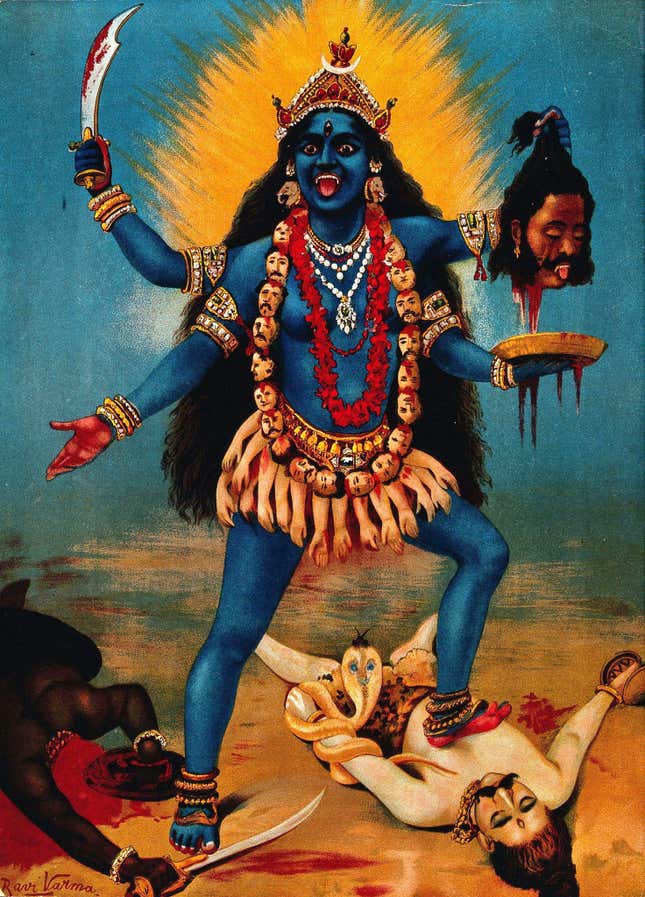
Kali is a Hindu goddess of destruction and creation. And for reasons that should surprise no one, Kali symbolism is emerging within modern western culture (which otherwise never had much Hindu influence). We see this intentionally in the Rolling Stones Logo, as well as in Jungian archetypes such as the "devouring mother", as well as in countless novels and comics.
While this is arguably a perversion of orthodox Hinduism, the symbolism is clear and even western feminists are appropriating Kali Maa.
Ms. magazine cover in 1972
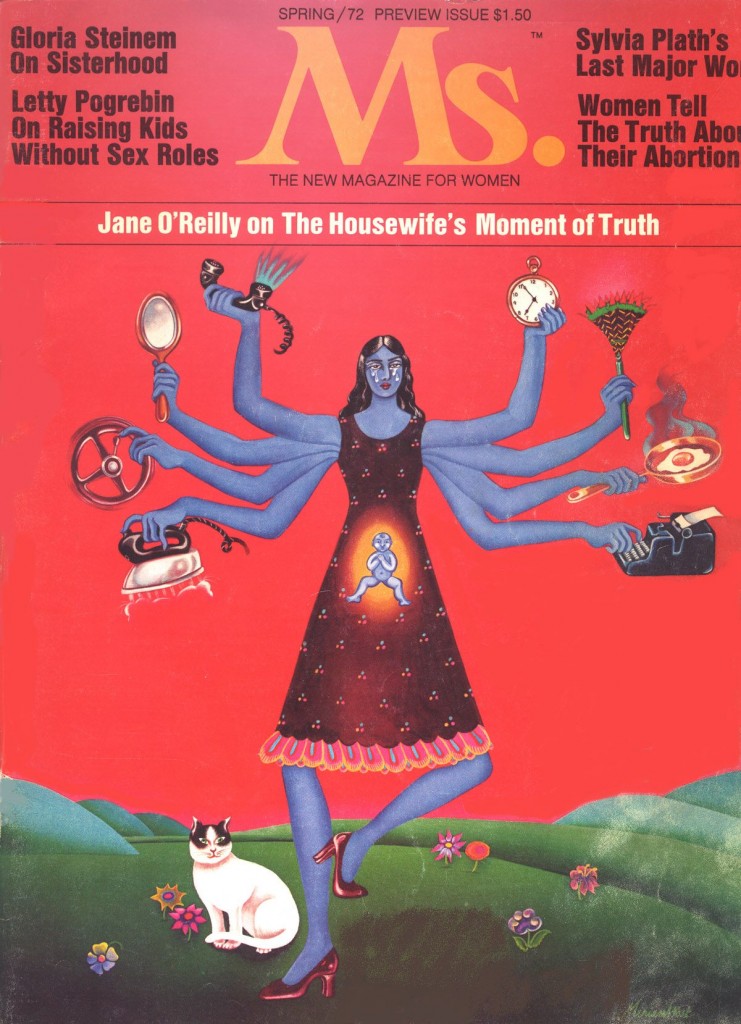
And should anyone think this is benign and some misunderstanding or misrepresentation, because obviously Kali isn't a feminist icon, here is a more recent article that makes these claims very explicit:
Kali is the 3,000-year-old feminist icon we need today
This makes Kali the feminist icon we need today, in that she is a complex figure of many contrasting traits, all of which are equally worthy expressions of female strength—unapologetic because it doesn’t even consider that there could be anything to apologise for.
While a sincere scholar of Hinduism could say this is a blatant misunderstanding of Kali, and of course that's true in the sense that Hinduism isn't exactly feminist, but the symbolism of Kali is also very clear. Perhaps it's the scholars that are misunderstanding Kali, especially if they can't explain why her image is suddenly so popular within modern western culture.
Kali imagery is clearly demonic and completely unbounded by any pretense of goodness or truth. Try to articulate an honest truth claim about Kali that all cultures that worship Kali would agree with. What fruits do we see from Kali worship?
Let's look at some other examples.
Ouroboros

The ouroboros, that old serpent eating its own tail. We see this image throughout the ancient world, especially in ancient Egypt and Babylon. It is associated with alchemy, such as in the mythos of Hermes Trismigestus. Which, incidentally, is also where we get Hermeticism and the modern worship of medical doctors. See the caduceus icon, which is the staff of Hermes Trismigestus. In the caduceus the serpents are bound to the staff, explicitly breaking the ouroboros (subordinating the serpents under a higher principle).
Caduceus
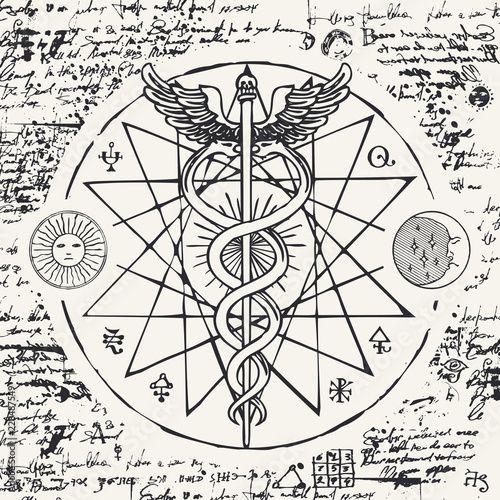
We also see the ouroboros in ancient Christian iconography in images of Leviathan, sometimes described as the world serpent, a primordial dragon of chaos. We see the same imagery in Tiamat (Mesopotamian) and Typhon (Greek).
Leviathan, Behemoth, Ziz
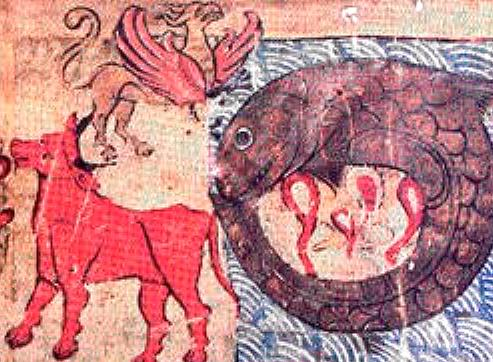
The above icon shows Leviathan in the classic ouroboros position, and also shows Behemoth, the great primordial beast, and also Ziz, the primordial bird.
Not all ancient images of Leviathan were as an ouroboros, sometimes Leviathan is depicted as a "hellmouth", literally eating damned souls. But Leviathan is universally a serpent.
Leviathan and Behemoth by William Blake
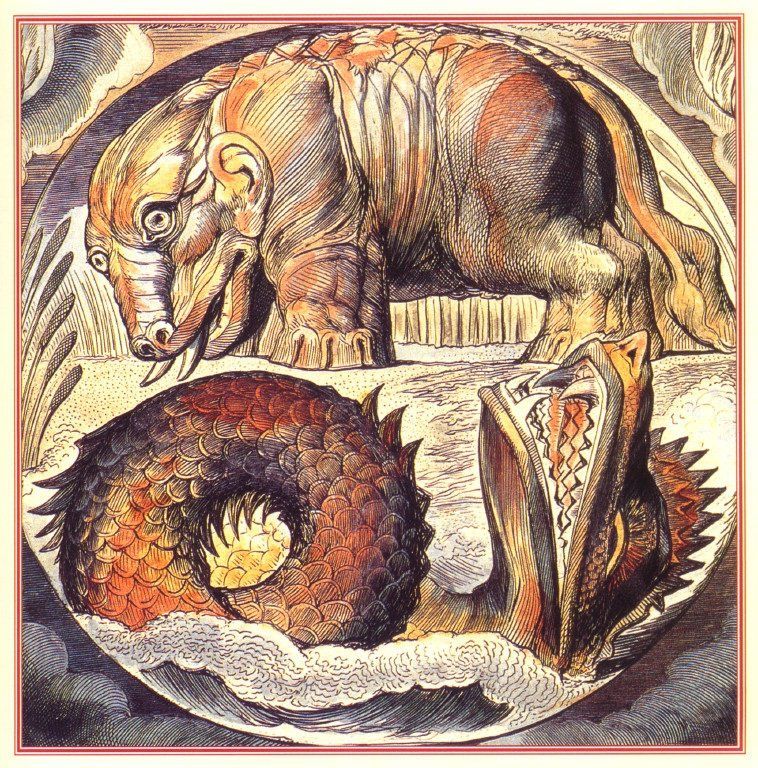
Sometimes, as in the above William Blake artwork, an ouroboros-like motif is created using both Behemoth and Leviathan, making a kind of beastly yin-yang, contrasting order and chaos in the form of primordial beasts (note the related beasts from the Book of Daniel and the Book of Revelation).
The key to understanding the ouroboros is that it represents cyclical completion. This is a Luciferian worldview where creation is complete and total, self-sustaining in and of itself, requiring no external creator (neither essence nor energy), that nothing is uncreated. The serpent in an ouroboros is sufficient in and of itself (needing nothing else).
Not only do we see ouroboros iconography resurging in modern culture, it is part of a broader Luciferian resurgence. Here's an explicit example from 1971,
Saul Alinsky, Rules for Radicals, 1971
Lest we forget at least an over-the-shoulder acknowledgment to the very first radical: from all our legends, mythology, and history (and who is to know where mythology leaves off and history begins or which is which), the first radical known to man who rebelled against the establishment and did it so effectively that he at least won his own kingdom – Lucifer
An easy way to understand serpent iconography is as primordial chaos, and when in an ouroboros position it is explicitly Luciferian, or at least trying to be. Contrast this with the broken ouroboros imagery where there's a higher ordering principle touching heaven, typically a staff (such as the staff of Moses in Exodus, or the staff of Hermes Trismigestus) but also the cross where Christ is as the serpent, explicitly breaking the ouroboros in the cross and putting the serpent in its place under a divine ordering principle.
And finally there's the original Luciferian serpent imagery (ouroboros or otherwise), "that old serpent" himself, Satan.
Satan
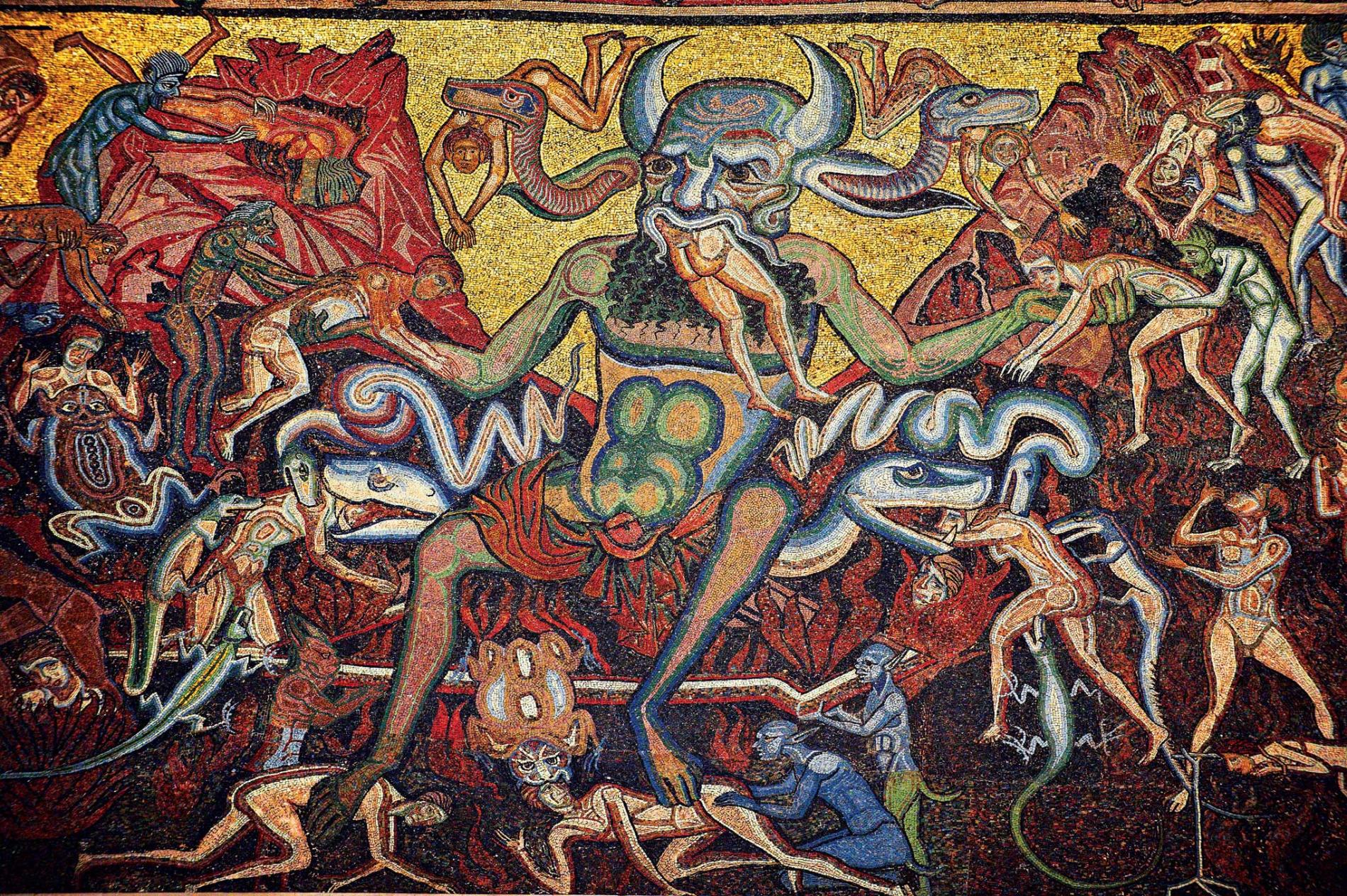
From an artistic perspective, modern use of satanic imagery has become so common as to become dull and hackneyed. It has become so predictable and ubiquitous in our culture that you're almost surprised when modern art or a music video doesn't feature explicit satanic imagery. When not using explicit imagery, the themes of modern film and television often promote Luciferian themes: "you can be anything you want", "the power was in you all along", "you just need to believe in yourself", and so on.
The list of ancient "gods" (Satan included) seems endless, and in all you'll find deceit and confusion -- such as with Kali or Satan or the many inversions such as the Prometheus mythology. When you try to pin down an objective truth claim (what is its exact meaning and purpose?) you'll never really get a complete answer, but always vague inferences as if they're approaching an answer that is forever out of reach: themes of power and influence, order out of chaos, destructive revolutions, etc. You'll get a snake eating its own tail.
And to be clear, these are the ancient "gods" in all their deceitful glory. There is never objective knowable truth when dealing with them, never explicit meaning or answers to the fundamental questions. This is the case whether you're studying Jungian archetypes, or attempting to worship pagan gods directly, or indirectly as in the modern worldview. It's always deceit at every level.
That said, these deceitful "gods" are the background for which we can understand ancient Christianity and how it succeeded against what would seem like overwhelming opposition.
Messianic Age¶
Today, the ancient "gods" have no real power other than to deceive. We know this because Christ has triumphed over them. Salvation is available to everyone. Christ is calling us to participate in His victory as He crushes the seeds of the serpent.
Unlike the milquetoast shallowness of modern Christianity, which attempts to subordinate Christ into an enlightenment worldview, ancient Christianity understood that Christ is both God and man, the Spirit of Truth, the logos incarnate, who subordinates all other worldviews, including the so-called "gods" of the ancient world.
Matthew 7:5
Thou hypocrite, first cast out the beam out of thine own eye; and then shalt thou see clearly to cast out the mote out of thy brother's eye.
The competing worldviews are beams in our eye, deceiving us and drawing us away from Truth. Christ is Truth. We can let Christ into our hearts, saving our souls, or we turn away and fall prey to the nihilistic deceptions of those ancient "gods".
For this is the Messianic Age. Christ triumphed over death and sin, and He is now ruling in the midst of His enemies. These "enemies" are the fallen spirits, the powers and principalities that once had unquestioned dominion over mankind; the consequence of the third rebellion against God:
Genesis 11:6-8 -- Tower of Babel
And the LORD said, Behold, the people is one, and they have all one language; and this they begin to do: and now nothing will be restrained from them, which they have imagined to do.
Go to, let us go down, and there confound their language, that they may not understand one another's speech.
So the LORD scattered them abroad from thence upon the face of all the earth: and they left off to build the city.
Deuteronomy 32:8
When the Most High gave to the nations their inheritance, when he divided mankind, he fixed the borders of the peoples according to the number of the sons of God.
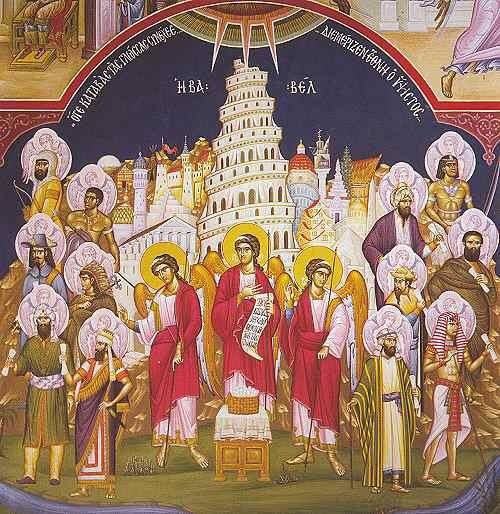
Wisdom of Sirach 17:17
For in the division of the nations of the whole earth He set a ruler over every people; but Israel is the Lord's portion
These territorial spirits (shedim) are among the ancient "gods", many of whom participated in the rebellions against God, and it is in this backdrop that Christ arose. It was in that scattered world of subjugation by ancient "gods" that Israel emerged and the prophets cried out for a savior, where John the Baptist prepared the way. "Repent, for the kingdom of heaven is at hand".
Ladder of Divine Ascent
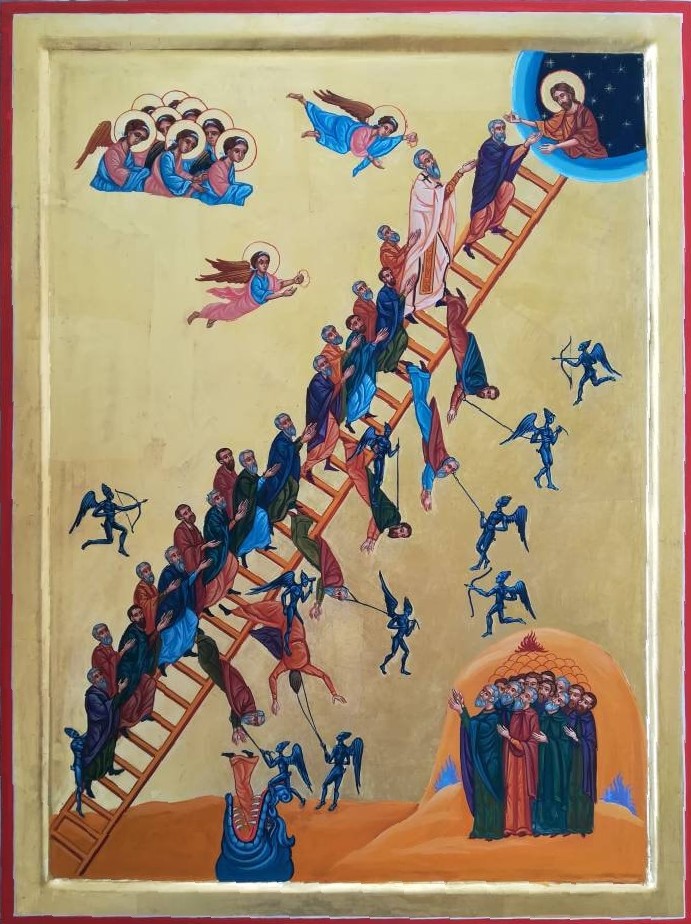
The fallen spirits are completely subject to Christ and all who come in His name. They tempt and torment, pulling us down and away from God, but they have no power over Christ and His kingdom.
And we who are born in this age are called to participate in His triumph over death and sin. We are called to choose Christ, to choose the kingdom of heaven over the kingdom of man.
Last Judgment
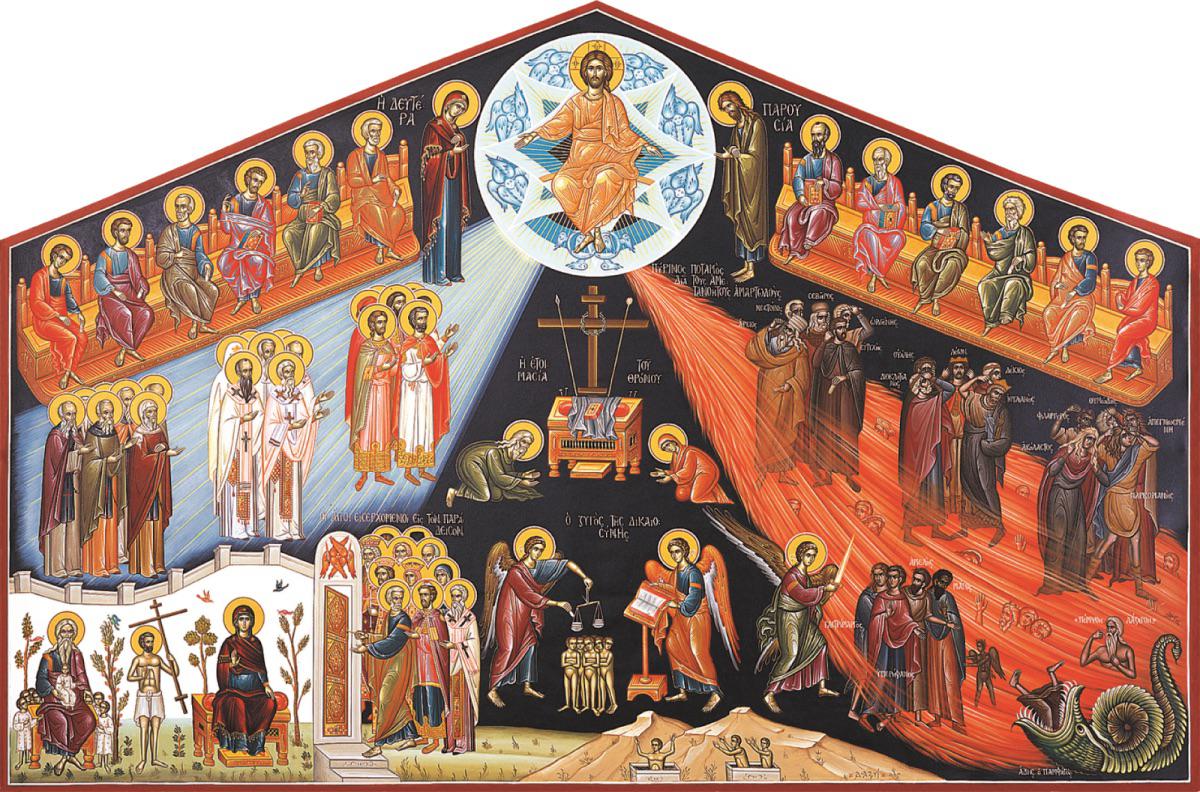
And we find two ways to walk this narrow path into the kingdom of God: monasticism and marriage. Marriage is the path for raising children in a consecrated union of man and woman. Monasticism is the path for divine spiritual ascent in a consecrated celibacy.
These two ways are mutually supportive of one another. In fact, they represent the two natures of Christ, for Christ is both man and God. Christ was born of a good marriage and lived in the world as a carpenter, and He simultaneously lived in consecrated celibacy, preaching and fulfilling the law.
In a Christian marriage, the husband/father is the head of the household, raising children, ministering to his wife, and worshipping God. The wife/mother is the heart of the family, nurturing and raising children, ministering to her husband, and worshipping God. And these families who are baptized in water and spirit, with Christ in their hearts, they have the divine mark of faith that is Christ Jesus such that they act out God's will. In fact, the so-called mark of the beast is nothing but a mockery of this divine mark (forehead representing faith, hand representing action).
In a Christian marriage, the family is an institution that triumphs over worldly empires, because those families serve Christ and not worldly powers. For He is ruling in the midst of His enemies, and to align ourselves with Christ is to make ourselves like David in his battle with Goliath.